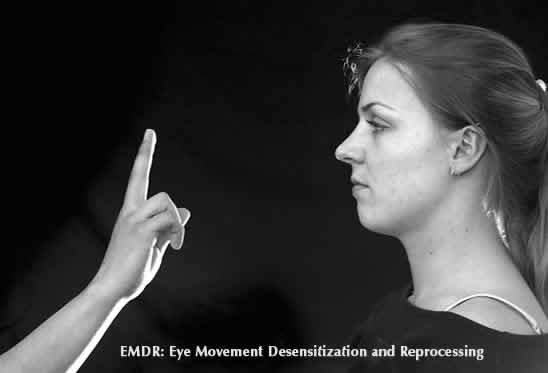What Is EMDR Therapy?
Eye Movement Desensitization and Reprocessing, or EMDR, is a powerful new psychotherapy technique which has been very successful in helping people who suffer from trauma, anxiety, panic, disturbing memories, post traumatic stress and many other emotional problems. Until recently, these conditions were difficult and time-consuming to treat. EMDR is considered a breakthrough therapy because of its simplicity and the fact that it can bring quick and lasting relief for most types of emotional distress.
EMDR is the most effective and rapid method for healing PTSD (Post Traumatic Stress Disorder) as shown by extensive scientific research studies.
The EMDR therapy uses bilateral stimulation, right/left eye movement, or tactile stimulation, which repeatedly activates the opposite sides of the brain, releasing emotional experiences that are "trapped" in the nervous system. This assists the neurophysiological system, the basis of the mind/body connection, to free itself of blockages and reconnect itself.
As troubling images and feelings are processed by the brain via the eye-movement patterns of EMDR, resolution of the issues and a more peaceful state are achieved.
How Does It Work?
The therapist works gently with the client and asks him/her to revisit the traumatic moment or incident, recalling feelings surrounding the experience, as well as any negative thoughts, feelings and memories. The therapist then holds her fingers about eighteen inches from the clients face and begins to move them back and forth like a windshield wiper. The client tracks the movements as if watching ping pong. The more intensely the client focuses on the memory, the easier it becomes for the memory to come to life. As quick and vibrant images arise during the therapy session, they are processed by the eye movements, resulting in painful feelings being exchanged for more peaceful, loving and resolved feelings.

What is the History of EMDR?
Since the initial medical study in 1989 positive therapeutic results with EMDR have been reported with the following populations:
- People who have witnessed or been a victim to a disaster (rape, accidents, earth quakes, fires, murder, gang related violence)
- Clients suffering from PTSD (post traumatic stress disorder)
- Suffers of panic disorders and anxiety attacks
- Suffers of phobias
- Chemically dependent clients
- Persons exposed to excess loss ( loss by death, divorce, loss of a house by fire)
- Crime victims and police officers who were once overcome with violent memories
- Accident or burn victims
Although a fairly new therapeutic technique, EMDR is meeting with much success all across the county. EMDR is a natural process. The client and the therapist become partners on a journey to help move traumatic and blocked energy. Together they work to transcend and free up the energy, so the client can return to their natural grounded state of being. The goal of this work is to help the client heal, so they can return to their life in peace.
How do I know if EMDR is right for me?
There are a number factors to consider when evaluating the appropriateness of EMDR therapy for a client's particular situation and history. During your initial consultation with a trained EMDR therapist, all the relevant factors will be discussed in full to help you both come to a decision to move forward with EMDR.
What problems are helped by EMDR?
The studies to date show a high degree of effectiveness with the following conditions:
| * loss of a loved one |
* fire |
* car accident |
| * work accident |
* assault |
* robbery |
| * natural disaster |
* rape |
* injury |
| * witness to violence |
* sexual abuse |
* childhood abuse |
| * victoms of violent crimes |
* trauma |
* physical abuse |
| * post traumatic stress |
* phobias |
* low self-esteem |
| * overwhelming fears |
* fears |
* childhood trauma |
| * performance and test anxiety |
* illness |
* panic attacks |
| * brooding or worrying |
* trouble sleeping |
* anxiety or panic |
| * relationship problems |
* depression |
* bad temper |
The EMDR technique is most effective when used in conjunction with other traditional methods of therapy in treating these and many other emotional disorders.
EMDR therapy can help clients replace their anxiety and fear with positive images, emotions and thoughts.

What are the Symptoms that
can be helped by EMDR?
- High anxiety and lack of motivation
- Depression
- Memories of a traumatic experience
- Fear of being alone
- Unrealistic feelings of guilt and shame
- Fear of being alone
- Difficulty in trusting others
- Relationship problems


